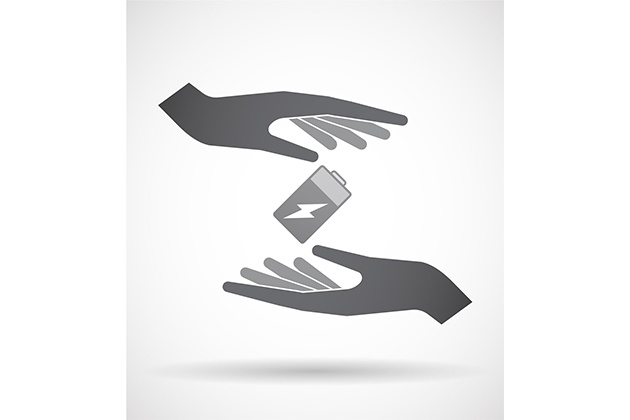研究により、私たちが毎日使用するバッテリーをより弾力性があり、強力で安全なものにする方法が発見されました。
The year is 2018 and our everyday livesare now fuelled by different gadgets which either run on 電気 or on batteries. Our reliance on battery-operated gadgets and devices is growing phenomenally. A バッテリー is a device that stores chemical energy that gets converted into electricity. Batteries are likemini chemical reactors having reaction producing electronsfull of energy which flow through the external device.Whether its cell phones or laptops or other even electric vehicles, batteries – generally lithium-ion – is the main power source for these technologies. As technology keeps advancing, there is continuous demand for more compact, high capacity, and safe rechargeable batteries.
バッテリーには長く輝かしい歴史があります。 アメリカの科学者ベンジャミン・フランクリンは、1749年に、リンクされたコンデンサのセットを使用して電気で実験を行っているときに、最初に「バッテリー」という用語を使用しました。 イタリアの物理学者アレッサンドロボルタは、塩水に浸した布で分離された銅(Cu)と亜鉛(Zn)のディスクを積み重ねたときに、1800年に最初のバッテリーを発明しました。 最も耐久性があり、最も古い充電式電池の1859つである鉛蓄電池は、XNUMX年に発明され、現在でも自動車の内燃機関を含む多くのデバイスで使用されています。
バッテリーは長い道のりを歩んできましたが、今日ではメガワットの大きなサイズからさまざまなサイズがあります。理論的には、ソーラーファームからの電力を蓄え、小さな都市を照らすことができます。または、電子時計で使用されるものと同じくらい小さい場合もあります。 、素晴らしいですね。 いわゆる一次電池では、電子の流れを生み出す反応は不可逆的であり、最終的にその反応物のXNUMXつが消費されると、電池は平らになるか死にます。 最も一般的な一次電池はマンガン乾電池です。 これらの一次電池は大きな問題であり、そのような電池の廃棄に取り組む唯一の方法は、それらを再利用できる方法を見つけることでした。つまり、充電可能にすることです。 電池を新しいものと交換することは明らかに非現実的であり、したがって電池がより多くなるにつれて 強力な そして大きく、それらを交換して処分するのにかなりの費用がかかることは言うまでもなく、ほぼ不可能になりました。
Nickel-cadmium battery (NiCd) was the first popular rechargeable batteries which used an alkali as an electrolyte. In 1989 nickel-metal hydrogen batteries (NiMH) were developed having longer life than NiCd batteries. However, they had some drawbacks, mainly that they were very sensitive to overcharging and overheating specially when they were charged say to their maximum rate. Therefore, they had to be charged slowly and carefully to avoid any damage and required longer times to get charged by simpler chargers.
Invented in 1980, Lithium-ion batteries (LIBs) are the most commonly used batteries in consumer (エレクトロニック devices today. Lithium is one of the lightest elements and it has one of the largest electrochemical potentials, therefore this combination is ideally suited for making batteries. In LIBs, lithium ions move between different electrodes through an electrolyte which is made of salt and オーガニック solvents (in most traditional LIBs). Theoretically, lithium metal is the most electrically positive metal having very high capacity and is the best possible choice for batteries. When LIBs are underdoing recharging, the positively charged lithium ion becomes lithium metal.Thus, LIBs are most popular rechargeable batteries for use in all kinds of portable devices owing to their long life and high capacity. However, one major problem is that the electrolyte can evaporate easily, causing a short-circuit in the battery and this can be a fire hazard. In practice, LIBs are really unstable and inefficient as over time the lithium dispositions become non-uniform.LIBs also have low charge and discharge rates and safety concerns make them unviable for many high power and high capacity machines, example electric and hybrid electric vehicles. LIB has been reported to exhibit good capacity and retention rates at very rare occasions.
したがって、近年、多くのバッテリーは、発火し、信頼性が低く、時には非効率的であるため、安全でないとマークされているため、バッテリーの世界ではすべてが完璧ではありません。 世界中の科学者は、小型で安全に充電可能で、軽量で、弾力性があり、同時により強力な電池を構築することを求めています。そのため、焦点は、潜在的な代替品として固体電解質に移っています。 多くのオプションが科学者によって試されてきたので、これを維持しますが、安定性とスケーラビリティはほとんどの研究のハードルでした。 高分子電解質は、安定しているだけでなく、柔軟性があり、安価であるため、大きな可能性を示しています。 残念ながら、このような高分子電解質の主な問題は、導電性と機械的特性が低いことです。
ACSで発表された最近の研究では ナノの手紙, 研究者 have shown that a battery’s safety and even many other properties can be enhanced by adding nanowires to it, making the battery superior. This team of researchersfrom College of Materials Science and Engineering, Zhejiang University of Technology, China have built upon their previous research where they made magnesium borate nanowires which exhibited good mechanical properties and conductivity. In the current study they checked if this would also be true for batteries when such ナノワイヤー 固体高分子電解質に添加されます。 固体電解質は、5、10、15、および20重量のホウ酸マグネシウムナノワイヤーと混合されました。 ナノワイヤーは、固体ポリマー電解質の導電率を増加させ、ナノワイヤーなしの以前と比較して、電池をより頑丈で弾力性のあるものにすることが見られた。 この導電率の増加は、電解質を通過して移動するイオンの数がはるかに速い速度で増加したためです。 セットアップ全体はバッテリーのようでしたが、ナノワイヤーが追加されました。 これは、通常のバッテリーと比較して、より高いパフォーマンス率とサイクルの増加を示しました。 可燃性の重要なテストも実行され、バッテリーが燃えないことがわかりました。 携帯電話やラップトップなど、今日広く使用されているポータブルアプリケーションは、最大かつ最もコンパクトな蓄積エネルギーでアップグレードする必要があります。 これは明らかに激しい放電のリスクを高め、必要なバッテリーのフォーマットが小さいため、そのようなデバイスでは管理可能です。 しかし、バッテリーのより大きなアプリケーションが設計され、試されているため、安全性、耐久性、および電力が最も重要であると見なされます。
***
{引用元のリストにある以下のDOIリンクをクリックすると、元の研究論文を読むことができます}
ソース
Sheng O etal。 2018. Mg2B2O5ナノワイヤー対応の多機能固体電解質で、高いイオン伝導性、優れた機械的特性、および難燃性を備えています。 ナノレター。 https://doi.org/10.1021/acs.nanolett.8b00659






































